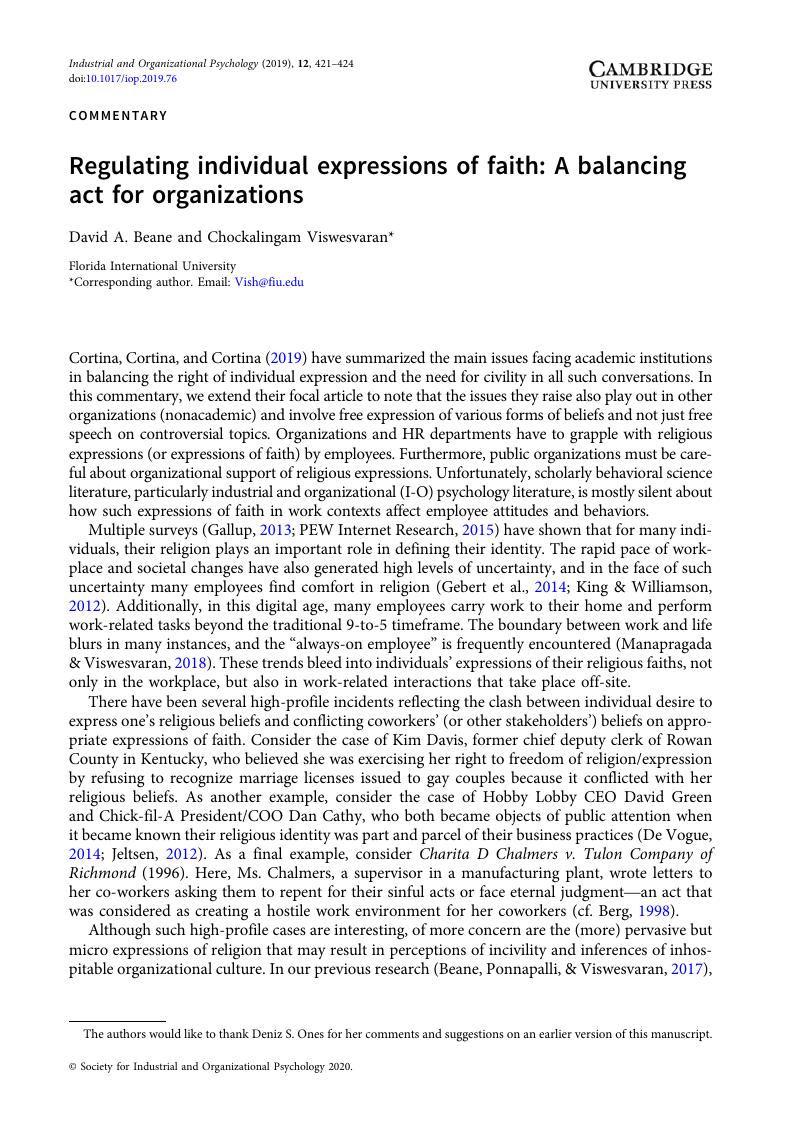No CrossRef data available.
Article contents
Regulating individual expressions of faith: A balancing act for organizations
Published online by Cambridge University Press: 14 January 2020
Abstract
An abstract is not available for this content so a preview has been provided. Please use the Get access link above for information on how to access this content.

- Type
- Commentaries
- Information
- Copyright
- © Society for Industrial and Organizational Psychology 2020
Footnotes
The authors would like to thank Deniz S. Ones for her comments and suggestions on an earlier version of this manuscript.
References
Beane, D., Ponnapalli, A. R., & Viswesvaran, C. (2017). Workplace religious displays and perceptions of organization attractiveness. Employee Responsibilities and Rights Journal, 29(2), 73–88. DOI: 10.1007/s10672-016-9286-9.CrossRefGoogle Scholar
Berg, T. C. (1998). Religious speech in the workplace: Harassment or protected speech. Harvard Journal of Law & Public Policy, 22, 959.Google Scholar
Borstorff, P. (2011). Protecting religion in the workplace? What employees think. Journal of Legal, Ethical and Regulatory Issues, 14(1), 59–70.Google Scholar
Cortina, L. M., Cortina, M. G., & Cortina, J. M. (2019). Regulating rude: Tensions between free speech and civility in academic employment. Industrial and Organizational Psychology: Perspectives on Science and Practice, 12(4), 357–375.Google Scholar
de Vogue, A. (2014). Hobby Lobby wins contraceptive ruling in Supreme Court. ABC News. Retrieved from http://abcnews.go.com/Politics/hobby-lobby-wins-contraceptive-ruling-supreme-court/story?id=24364311.Google Scholar
Gallup Inc., (2013). Religion. Retrieved from http://www.gallup.com/poll/1690/religion.aspxGoogle Scholar
Gebert, D., Boerner, S., Kearney, E., King, J. E. Jr., Zhang, K. & Song, L. J., (2014). Expressing religious identities in the workplace: Analyzing a neglected diversity dimension. Human Relations, 67(5), 543–563.CrossRefGoogle Scholar
Hunter, J. E., & Schmidt, F. L. (1977). Critical analysis of the statistical and ethical implications of various definitions of test bias. Psychological Bulletin, 83, 1053–1071.CrossRefGoogle Scholar
Jeltsen, M. (2012). Chick-Fil-A has “record-setting day” while embroiled in anti-gay controversy. Huffington Post. Retrieved from http://www.huffingtonpost.com/2012/08/02/chick-fil-a-has-record-setting-day-anti-gay_n_1733697.htmlGoogle Scholar
King, J. E., & Williamson, I. O. (2010). Workplace religious expression, religiosity, and job satisfaction: Clarifying a relationship. Journal of Management, Spirituality & Religion, 2(2), 173–198. doi: 10.1080/14766080509518579.CrossRefGoogle Scholar
King, J. E., & Williamson, I. O. (2012). Spirituality, recruiting, and total wellness: Overcoming challenges to organizational attraction. Journal of Management, Spirituality & Religion, 9(3), 237–253. doi:10.1080/14766086.2012.728881.CrossRefGoogle Scholar
Manapragada, A., & Viswesvaran, C. (2018, April). Examining work-related email use after hours and employee burnout. Poster presented at the 33rd Annual Conference of the Society for Industrial and Organizational Psychology, Chicago, IL.Google Scholar
Pew Research Center. 2015. Millennials surpass Gen Xers as the largest generation in U.S. labor force. Retrieved from http://www.pewresearch.org/fact-tank/2015/05/11/millennials-surpass-gen-xers-as-the-largest-generation-in-u-s-labor-forceGoogle Scholar




